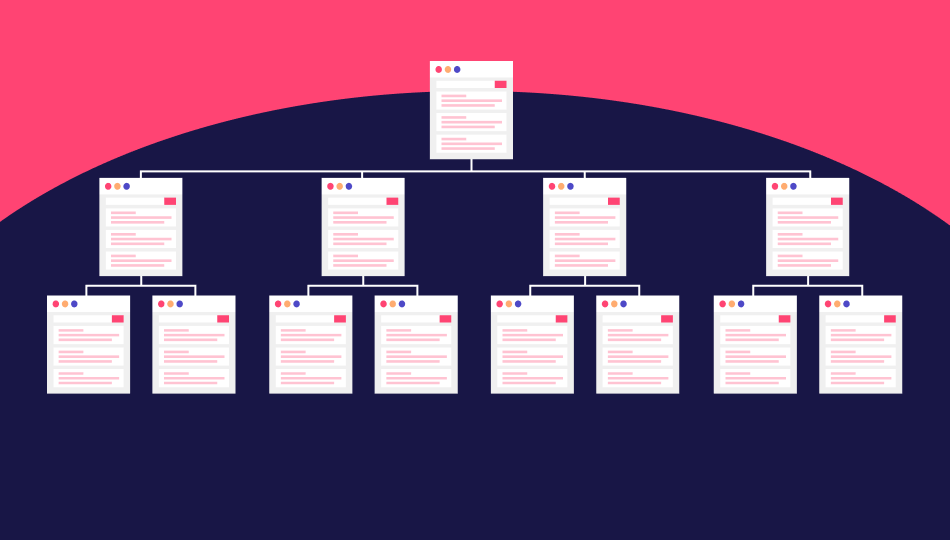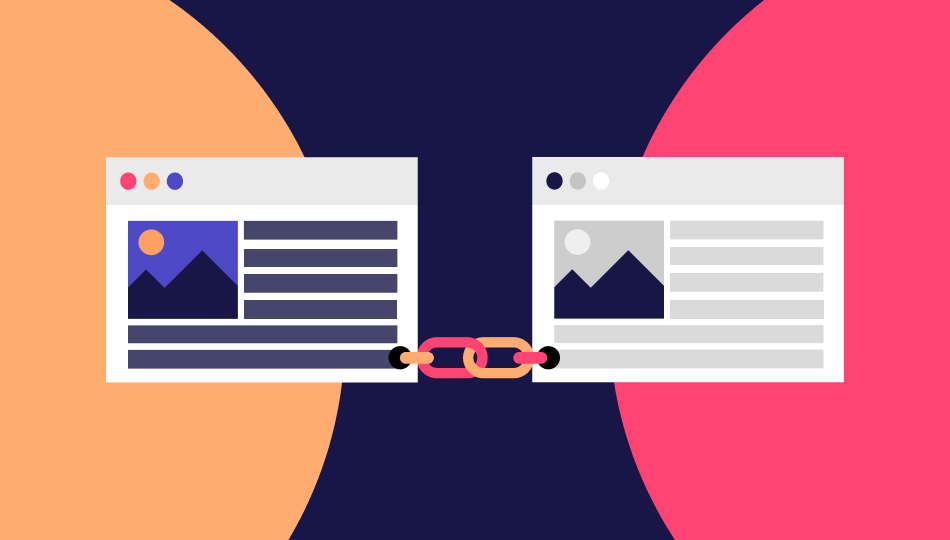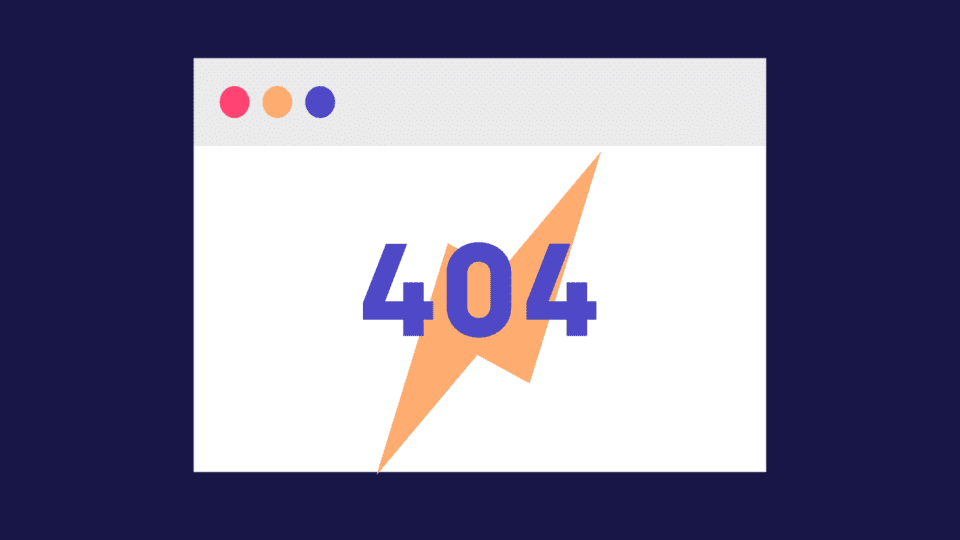SEO stands for search engine optimization. You can almost hear what it is, but to clarify, it is the process of making your site better and easier to understand for a search engine.
The primary goals of SEO are:
– Increasing the quantity and quality of organic traffic to your website
– Increasing the ranking positions for your target keywords through organic search engine results
We are going to break it down into what type of activities you need to optimize, to increase your visibility in the search engines.
How does a search engine work?
Think of search engines as libraries, but instead of storing books, they store copies of websites and webpages in their index. When you search for a query – a keyword –, the librarian (search engine) runs through the entire library to choose which books that match the query.
In reality, Google or another search engine will take your keyword and search amongst billions of stored copies of web pages in their index. They take the keyword and match it against web pages, and rank them based on over 200 signals. Based on factors such as relevance, popularity, and how others are using the keyword, the search engines try to find the best results to answer your query.

How to start working with keywords
Keywords are a huge part of SEO and a great place to start. First of all, you need to start with filling out a keyword brief. A keyword brief is a document where you list all of your products and services. Be as specific as you can.
Let’s say you’re an e-commerce company that sells shoes, shoe soles, impregnation, and accessories. In that case, start by breaking down your specific products into categories like sneakers, Chelsea boots, loafers, sandals, and so on. Also, make a list of your competitor’s keywords and their URLs where you can scan or manually find ideas for keywords.

How SEO tools can help
Once you have your keyword brief, you are probably eager to get started. An easy way is by investing in an SEO tool. Ahrefs, Semrush, and Moz are three examples. If you are unsure of how much you will work with improving your SEO, Ahrefs has a free keyword tool. Although, If you want to achieve better results with your organic online presence, investing in an SEO tool is recommended.
Let’s take an example by using Ahrefs. Start by typing in a broad keyword to start with, like “sneakers”. For this word, the results show us 476,000 keywords with the monthly search volume in the US. A bit overwhelming!
That is why the best alternative at this point is to filter this down and categorize the different types of keywords in topics and search intent. That way, you can cover the entire buyer’s journey. We’ll teach you how!
How to align keywords with your buyer’s journey
Before you start categorizing keywords, you should understand why. The answer is; you want to cover the entire buyer’s journey. You have to create different types of content to match the intent of where the customers are in their buyer’s journey. This will result in increased awareness, better relationships, and ultimately… More sales!
To map out keywords according to the buyer’s journey, we’ll look at search intent and a customer journey model.
Search intent is the reason behind the searcher’s query. With this knowledge, and the See, Think, Do, Care model in mind, you can adjust your keywords according to the different search intents that your customers have in different stages of their buying journey. Below are some examples of searches that people might make in their different phases:

See:
The See phase, also called the awareness phase or attention phase.
In this phase, you can create informational content in various forms on your website about your products, for example:
“How to lace sneakers”
“How to clean white sneakers”
Think:
In the Think phase, customers are aware of their needs and they evaluate their options – but they’re not ready to convert yet.
In this phase, you might create specific buying guides for your products or services, like how to find the perfect sneakers for your needs, usage, and activities, for example:
“Best sneakers for walking”
“Best sneakers for when you are on your feet all day”
Do:
The Do-phase is also known as the transactional or conversion phase. In this phase, customers are well aware of their needs, they evaluate the solution or products that you offer, and they are ready to convert. An example of a search in this phase would be:
“Buy sneakers”
“Cheap sneakers”
Many companies only act within this phase in the belief that it will generate sales. However, this phase is the one with the lowest search volumes. This means that if you are ignoring the search queries that are informational or educational, you’re missing out on sales opportunities since you are not covering the entire customer’s buying journey. Also, remember that if a customer has been exposed to your brand and content, regardless of which phase they are in, it might increase the chances of them choosing your products instead of a competitor’s.
Care:
Last but not least is the Care-phase. In this phase, the customer has recently converted and new needs may arise with your solution. An example search in this phase would be:
”Best shoe cleaner for sneakers”.
To create high customer loyalty, it is important to take care of the customers in this category and create added value on our website for existing customers. The aftermarket process starts, which includes a customer loyalty plan and other upselling activities.
To summarize:
You can’t communicate to customers with Do-phase content when the customers have just started their buyer’s journey. For example, if you have a social media account and you only publish product releases and features, you will probably not get as much engagement as if you created content that could help and educate people. In the same way, when customers are in the Do-phase, you want to communicate Do-phase content to close the deal, rather than sharing inspirational or educational content. By communicating the right content at the right time, you’ll get much better results!

How to choose keywords
So how do you choose the right keywords? The short answer is: it depends.
In our example with the US-based e-commerce company that sold shoes, the keyword “sneakers” is a very highly competitive keyword that the majority of e-commerce companies in the US would be unable to compete with against competitors like Nike, Nordstrom, Zappos, and so on.
One solution is to find other competitive keywords with lower competition. We’re going to take one example using Ahrefs.
Even if you are not using Ahrefs, this technique can be applied in a similar way using other keywords tools, too.
With that being said – in Ahrefs, go over to the phrase match column and set the Keyword difficulty to a maximum of 10.
By doing so, we can find new keywords that match what we offer, like “Black Sneakers” which has tons of traffic potential.
We can also head over to the questions column, where we find that the search phrase “How to clean white sneakers” is a very popular query.
It is a bit competitive, but still worth creating content around.
Why? Because based on its popularity, your audience will appreciate it!
Other key takeaways from keyword research
Keyword research will always give you and your business great insights and indicators on what your audience is looking for.
When you are finished with your keyword research, you are done with all that hard work of mapping it down to different categories, topics, and search intent. This is a great framework for all of your communication and channels. Think of search volume as an indicator for a supply and demand after certain products.
The most exciting thing about keyword research is that four out of five times, it will help you find opportunities to grow your business. For example, there may be a product or a product feature that you’re currently missing out on with a huge potential for your business growth.
In our previous example, it could be something as simple as a color!
Website structure and URLs
The keyword research becomes the basic foundation for how the website should be structured and how to create SEO-friendly URLs. At the top of the hierarchy is the start page. The pages you reach after one (1) click are next in line, and so on. In this step, we explore which pages we are missing and which we should add if we have a content gap.
In our example with the e-commerce company, we were missing out on a great opportunity with the category page “Black Sneakers”, based on the keyword research and the competitor analysis.

What are SEO-friendly URLs?
SEO-friendly URLs are URLs that are designed to meet the needs of users and searchers.
About 10 years ago, keywords in URLs and in the domain name were important ranking factors – but not anymore, according to Google’s John Mueller, Webmaster Trends Analyst.
“Keywords in URLs are overrated for Google SEO. Make URLs for users. Also, on mobiles, you usually don’t even see them.”
Just because a website has a keyword in its domain name doesn’t mean that it’s more relevant for that specific keyword, than other websites are. In short, you don’t need to put keywords in the domain name.
Instead, focus on URLs! Keep them short, and include a keyword that is relevant to your site’s content and structure for a better user experience. Avoid numbers and letters that only appear in your own language. Also, don’t change the URL structure unless you have very confusing URLs, such as “domain.com/7103_98_6/HJ_12KL/product__/”.
Although, if you have an e-commerce website with over a thousand products, having article numbers or product numbers, like this “domain.com/black-sneakers/nike-air-jordan/product-11”, works fine. Google understands you!

Technical SEO-analysis
NuNow, it’s time to start the technical part of the SEO project and perform a technical SEO analysis.
You could start the entire SEO process with the technical part. However, it’s a lot easier to start with the company’s information: what you sell, who your customers are, and what type of content you have already produced. This gives us a broad understanding of how the company is structured.
There are a couple of activities in the SEO analysis that correlates to the keyword research and the keyword brief. The first thing is backlink analysis and link profile. This is where we measure how strong your backlink profile is, compared to your competitors from the keyword brief.
Backlinks
Backlinks are links from one website to another. You can see them as votes; the more votes you get from credible sources, the higher the trust. There is a clear, positive correlation between the number of backlinks from unique websites and the effect on organic traffic.
Simply put, backlinks play an important role in SEO. Actually, backlinks are one of the most important and debated algorithms within the SEO industry. The more backlinks you have from unique domains, the more trustworthy and valuable you are for search engines. It’s a clear signal that this website is great!

Use backlinks to strengthen specific URLs
In general, almost 90 % of a company’s backlinks are linked to your website’s homepage. This means that the homepage gets almost all of your link boost, which is not that great. Why not? Because you want the links to guide people to pages with your most important products and services. This is especially important if you are in a competitive industry for a competitive keyword, like “Black Sneakers”. Here, the best thing would be for the external backlinks to guide people to that specific URL to gain strength and trustworthiness. If you are unable to control your incoming external links, make sure that your homepage links to the most important pages on your website.
Also, when your company is mentioned in the news, media, or blogs and you are able to decide which links to share – use links that guide people to important product or service pages.
Backlinks and link building
When doing a competitive analysis, you might find that you won’t be able to compete for certain keywords. Why not? Because you don’t have the same website strength as your competitors – yet. They may have a few more or a couple of hundred more backlinks from unique domains than you.
The easiest way is to compete for a less competitive keyword. The hardest but most rewarding way (if it’s done right) is link building. In short terms, link building is the process of getting new high-authority links to your website.
These high-authority links should always be:
– Earned and not bought
– From a relevant and trusted topic source
– Increase over time
– Bring qualified traffic to your site
A strong recommendation is to actively ensure that priority landing pages are strengthened with more external links if you have the opportunity to influence this. A press release is a well-known successful activity for an outreach link-building campaign. Other examples include collaborations and job advertisements.

Domain Rating for better organic rankings
Everyone loves shortcuts that actually work! Mynewsdesk Domain Rating can be your shortcut.
Domain Rating (DR) shows the strength of a website’s backlink profile compared to the others on a 100-point scale. Mynewsdesk has a DR of 89, which can be compared to some of the world’s most famous brands such as Netflix, Nike, H&M, and Coca-Cola.
As a result, our customers can compete with their blog posts and press releases against enterprise companies with a much stronger website. Publishing content on Mynewsdesk will allow you to rank for highly competitive keywords that you wouldn’t be able to rank for on your website. In other words, if you want to increase your organic visibility and brand awareness fast, Mynewsdesk is a great option.
Technical fixes
Secure website – SSL and HTTPS:
SSL stands for Secure Socket Layer and is a technology used to encrypt the traffic between a website on a web server and a visitor from a web browser. This makes it much more difficult for unauthorized people to “eavesdrop” on the traffic between the website and the visitor. SSL makes your website appear better among Google’s search results in front of pages that do not have SSL certificates and HTTPS URLs. Also, by using SSL, your website will come across as safe and secure, which can increase the chance of visitors choosing your website over competitors.
In summary: install an SSL certificate on your website and you are on the safe side.

Redirects:
The most common redirect is the 301 redirect. This is when you move a page to a new URL. By setting up a redirect from the previous page, you send all traffic that tries to enter the old URL, to the new URL. This way, you also keep all the backlinks you built.
Sitemap:
A sitemap is a file where you provide information about the pages and other files on your site, and the relationships between them. Search engines, like Google, read this file to crawl your site more efficiently. A sitemap tells Google which pages and files you think are important in your site and also provides valuable information about these files.
Send your website (sitemap) to Google:
When creating a new website, it will definitely be found by search engines at some point, as they constantly search through the web. To speed up that process, there are a few things that you can do. The first step is to let Google know that you exist, by actually submitting your website to Google. You can do this by submitting your Sitemap to Google Search Console. How to submit your sitemap to Google Search Console: 1.) Sign in to Google Search Console. 2.) In the sidebar, select your website. 3.) Click on ‘Sitemaps’.
Canonicals:
If you have two similar pages, and they are both eligible to rank for a certain keyphrase, the search engine simply doesn’t know which of the two URLs it should send the traffic to. To solve this, you can select a preferred URL, also known as a canonical URL.
Hreflang:
Hreflang is an attribute used to specify the language and geographical targeting of a webpage. If you have multiple versions of the same page in different languages, you can use the Hreflang tag to tell search engines like Google about these variations.

Structured data and rich results:
In practice, structured data is a content description for a page on your site that only search engines see.
The search engine processes the page data and presents the search results for your page in a way that best suits those who use the search engine. The most known structured data is when you google for recipes. Your content can already be presented on the search results page. For example, if you google “Muffin recipe”, you can see a picture from the page, reviews, baking time, and maybe even the whole recipe without even entering the webpage. These results are called rich results or rich snippets.
Website speed:
This is a ranking factor with a huge impact on user experience. There are statistics that show if your website loads in more than three seconds, 60 % of your traffic will leave your site immediately. Google released an update on this during the summer of 2021 with even higher page speed requirements. Therefore, run your website through Page Speed Insights and have a web developer look at your website.
Mobile-first:
A website needs to be optimized for mobiles. Mobile-first indexing means that Google uses the mobile version of the content for indexing and ranking. Historically, the index primarily used the desktop version of a page’s content when evaluating the relevance of a page to a user’s query.

404-pages:
Website visitors always expect to find what they are looking for on a functional page. Therefore, your 404-page should:
– Be easy to navigate
– Have links to your popular categories
– Maybe even have a search field, depending on what kind of website you have
If you have a lot of categories and products, a search box is a great idea.
Breadcrumbs:
This shows us a page’s position in a website’s hierarchy with links to the pages above. Breadcrumbs improve the internal link structure, which gives the search engines a better understanding of how the website is structured. It also gives website visitors a better user experience.
Click depth: This describes the number of clicks from the homepage that is needed before landing at another page – whether for users or search engine robots. A page linked from your homepage, for example, has a click depth of one.
It is critical for your most important products or services to have a low click depth.
Otherwise, the search engines will think that your specific page isn’t prioritized by you. Make it easy for search engines and users to find your most relevant content.

Anchor text:
This is the clickable text in a hyperlink, which you can see and find very often in blog posts. SEO best practices dictate that anchor text be relevant to the page you’re linking to, rather than generic text such as “Learn more” or “Watch the video”. The blue, underlined anchor text is the most common as it is the web standard, although it is possible to change the color. The keywords in anchor texts are one of the many signals search engines use to determine the topic of a web page.
SEO plugin (WordPress users):
If you use a CMS like WordPress it is very beneficial to use an SEO plugin like Yoast or Rankmath. You will get a user-friendly overview of how your website is doing and can at the same time make major “bulk” optimization or specific on-page optimization, technical details and so much more. This is a strong recommendation for WordPress users!
Content:
This is the single most important ranking factor there is. You can achieve amazing results if you are a good copywriter or content specialist.
You just need a little guidance. So let’s dig in!

On-page optimization
While creating content, you should keep on-page optimization in mind. On-page optimization is when you optimize your web pages according to your keywords to improve search visibility and traffic. How do you optimize your pages? On-page SEO refers to every SEO-related improvement you do on your website. Here are some examples:
Title tag
A title tag is the blue clickable link that appears on the search results page and is a very important ranking factor. To achieve great organic search results, you have to optimize your title tag for each page against your primary keyword for that page.
For best title tag practice, use this structure: primary keyword – secondary keyword (if it feels natural) – brand name.
Try to keep them short, Google starts cutting off title tags in the SERPs after around 50–60 characters. Try to keep it precise to the page and avoid stuffing keywords.
Meta description
Just underneath the title tag, we can see a description for a page.
Think of a meta description as a sales pitch. A meta description is not a ranking factor, but the meta descriptions’ click-through rate is. So try to make the description of your page as relevant and as clickable as possible.
For meta description best practice, answer these questions in the text:
– What is the page about?
– Why should the user click on your result?
– What do we want the user to do on this page?
Headings
Create a content hierarchy that makes it easy for a visitor to understand, read, and navigate through. This is also very important for a search engine so that they can understand what the page is about.
Think of headings as a book. The most important one is the H1, which tells you what the book is about. Then you have subheadings within that topic.
Best practice for headings are:
1. Primary keyword in H1 heading:
The main headline is a relevance factor. Use keywords and complete the title.
2. Keywords in subheadings if natural:
Keyword variation can be used. Although, keep the content easy to understand, read, and navigate through.
3. Think in blocks of information:
The heading should be descriptive of all content for the next heading at the same hierarchical level.
How to create content to improve SEO
When creating content, always keep the user in mind. Put on your hat of expertise, and create content that brings value for the users. Try to find out if there is anything within a certain topic that your competitors are missing.

Write better, longer, and more detailed content
In 2020, Backlinko did a study and analyzed over 11,8 million Google search results to answer the question: which factors correlate with first-page search engine ranking? The results showed that the average content length in the top 10 results for most keywords was 1 447 words long.
Longer content gives search engines more information about the topic of that webpage. This makes them more confident that your page is a relevant result for the specific keyword. Also, is it preferred to cover an entire topic on a single website page, rather than having multiple shorter pages covering different aspects of a topic.
Although, one of the most important parts of the user experience is to offer relevant content that matches search intent and expectations, and where keywords are used naturally.
Use the right format
Create content that matches people’s search intent. If Google’s results page (SERP) displays a lot of video or image results, this is an indicator that if you want to drive traffic for this keyword, you need to create video or image content. You will not be able to rank with text content since you are not matching the search intent.
SEO optimize images
Search engines use the alt-tag attribute to understand what the picture represents. This increases the relevancy to the page and increases the opportunity to be seen in Google Image Search. Use short alt tag descriptions on what the picture represents and use keywords if it matches the picture.
Why internal links matter
Without links, neither search engines nor users will find your content. Therefore, internal linking is essential to increase organic traffic. There are several types of internal links, such as links on your homepage, menu, and so on, but also links within your content.
These links point users as well as search engines to interesting and related content. They also help search engines understand how valuable a page is. When a page receives a lot of links, that indicates that it is important. This can be referred to as link value. You can increase the link value of new content by linking them from your homepage, which means that search engines will find that content quicker.
All in all, search engines consider pages that get a lot of valuable links as important. Therefore, internal linking will guide users and search engines to your most important pages and can increase your page’s organic rankings.

Why should I invest in SEO?
SEO can help you build better relationships with your audience, improve the customer experience, increase conversions, and increase your authority and brand recognition which gives you an edge over your competitors.
In other words, SEO means more sales, more loyal customers, and more growth for your business!
Here are three final reasons why you should invest in SEO:
- Search traffic is free
- Search traffic is typically consistent once you rank high
- You can reach a massive audience



